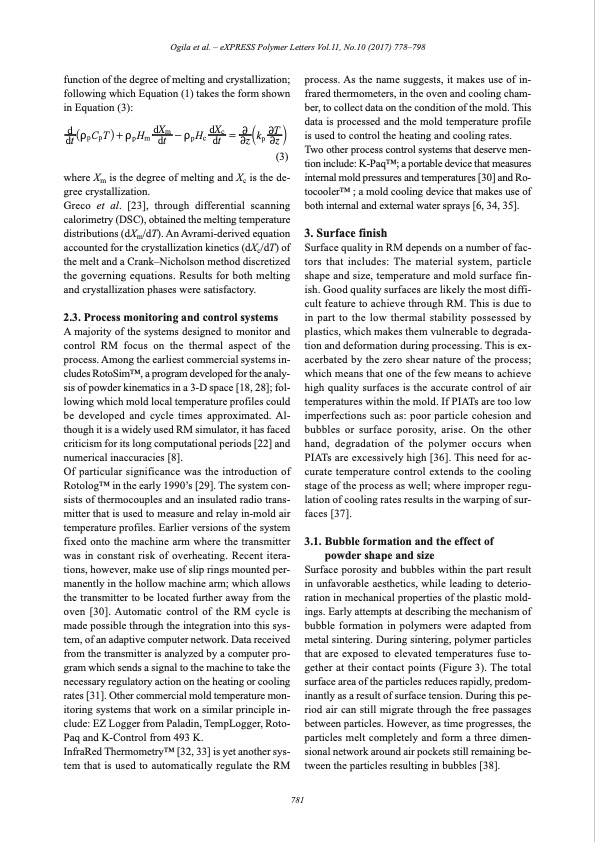
PDF Publication Title:
Text from PDF Page: 005
Ogila et al. – eXPRESS Polymer Letters Vol.11, No.10 (2017) 778–798 function of the degree of melting and crystallization; following which Equation (1) takes the form shown in Equation (3): d dXm dXc22T dtRtpCpTW+tpHm dt -tpHc dt = 2zTkp 2z Y (3) where Xm is the degree of melting and Xc is the de- gree crystallization. Greco et al. [23], through differential scanning calorimetry (DSC), obtained the melting temperature distributions (dXm/dT). An Avrami-derived equation accounted for the crystallization kinetics (dXc/dT) of the melt and a Crank–Nicholson method discretized the governing equations. Results for both melting and crystallization phases were satisfactory. 2.3. Process monitoring and control systems A majority of the systems designed to monitor and control RM focus on the thermal aspect of the process. Among the earliest commercial systems in- cludes RotoSimTM, a program developed for the analy- sis of powder kinematics in a 3-D space [18, 28]; fol- lowing which mold local temperature profiles could be developed and cycle times approximated. Al- though it is a widely used RM simulator, it has faced criticism for its long computational periods [22] and numerical inaccuracies [8]. Of particular significance was the introduction of RotologTM in the early 1990’s [29]. The system con- sists of thermocouples and an insulated radio trans- mitter that is used to measure and relay in-mold air temperature profiles. Earlier versions of the system fixed onto the machine arm where the transmitter was in constant risk of overheating. Recent itera- tions, however, make use of slip rings mounted per- manently in the hollow machine arm; which allows the transmitter to be located further away from the oven [30]. Automatic control of the RM cycle is made possible through the integration into this sys- tem, of an adaptive computer network. Data received from the transmitter is analyzed by a computer pro- gram which sends a signal to the machine to take the necessary regulatory action on the heating or cooling rates [31]. Other commercial mold temperature mon- itoring systems that work on a similar principle in- clude: EZ Logger from Paladin, TempLogger, Roto- Paq and K-Control from 493 K. InfraRed ThermometryTM [32, 33] is yet another sys- tem that is used to automatically regulate the RM process. As the name suggests, it makes use of in- frared thermometers, in the oven and cooling cham- ber, to collect data on the condition of the mold. This data is processed and the mold temperature profile is used to control the heating and cooling rates. Two other process control systems that deserve men- tion include: K-PaqTM; a portable device that measures internal mold pressures and temperatures [30] and Ro- tocoolerTM ; a mold cooling device that makes use of both internal and external water sprays [6, 34, 35]. 3. Surface finish Surface quality in RM depends on a number of fac- tors that includes: The material system, particle shape and size, temperature and mold surface fin- ish. Good quality surfaces are likely the most diffi- cult feature to achieve through RM. This is due to in part to the low thermal stability possessed by plastics, which makes them vulnerable to degrada- tion and deformation during processing. This is ex- acerbated by the zero shear nature of the process; which means that one of the few means to achieve high quality surfaces is the accurate control of air temperatures within the mold. If PIATs are too low imperfections such as: poor particle cohesion and bubbles or surface porosity, arise. On the other hand, degradation of the polymer occurs when PIATs are excessively high [36]. This need for ac- curate temperature control extends to the cooling stage of the process as well; where improper regu- lation of cooling rates results in the warping of sur- faces [37]. 3.1. Bubble formation and the effect of powder shape and size Surface porosity and bubbles within the part result in unfavorable aesthetics, while leading to deterio- ration in mechanical properties of the plastic mold- ings. Early attempts at describing the mechanism of bubble formation in polymers were adapted from metal sintering. During sintering, polymer particles that are exposed to elevated temperatures fuse to- gether at their contact points (Figure 3). The total surface area of the particles reduces rapidly, predom- inantly as a result of surface tension. During this pe- riod air can still migrate through the free passages between particles. However, as time progresses, the particles melt completely and form a three dimen- sional network around air pockets still remaining be- tween the particles resulting in bubbles [38]. 781PDF Image | Rotational molding: A review

PDF Search Title:
Rotational molding: A reviewOriginal File Name Searched:
Rotational_molding_A_review_of_the_models_and_mate.pdfDIY PDF Search: Google It | Yahoo | Bing
Development of a solar powered Electric Ship The Electricship website originally started off as a project to develop a comprehensive renewable, affordable, modular electric ship... More Info
Modular Boat Hull Composite The case for a unsinkable, modular composite hybrid boat hull... More Info
MS Burgenstock Hybrid Electric Catamaran Lake Lucerne Unique shuttle servicing Lucerne to the Burgenstock Resort... More Info
Ground Power Unit GPU Powered by Lithium Ion Batteries The goal of the Ground Power Unit is to provide a readily accessible, modular, ready-to-power solution for remote power... More Info
| CONTACT TEL: 608-238-6001 Email: greg@electricship.com | RSS | AMP |